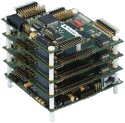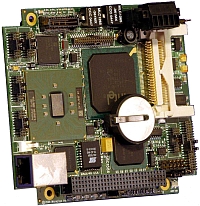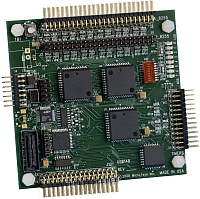Stackable USB standard aims at embedded apps
Feb 8, 2007 — by LinuxDevices Staff — from the LinuxDevices Archive — 9 views Embedded board vendor Micro/sys has created a stackable system architecture based on utilizing USB as a low-end I/O bus in compact, rugged, embedded systems. The company is already shipping CPU and I/O boards that implement the patent-pending technology, and hopes to license StackableUSB broadly.
Embedded board vendor Micro/sys has created a stackable system architecture based on utilizing USB as a low-end I/O bus in compact, rugged, embedded systems. The company is already shipping CPU and I/O boards that implement the patent-pending technology, and hopes to license StackableUSB broadly.
digg this story |
The StackableUSB specification defines mechanical connectors and electrical design considerations aimed at enabling multi-layer stacking of I/O boards above and below a single-board computer (SBC), or another I/O board.
The SBCs can be any size — Micro/sys specifically cites PC/104, EPIC, EBX, mini-ITX, and COM Express — and are processor-architecture independent (all that matters is the availability of USB expansion). The I/O boards are currently defined as having the identical outside dimensions as standard PC/104 modules: 3.550 x 3.775 inches (90 x 96 mm), with 0.6-inch (15mm) board-to-board spacing.
 StackableUSB (Click to enlarge) |
According to Micro/sys president Susan Wooley, StackableUSB can support up to 16 modules in a stack, distributed both above and below the USB bus master, typically an SBC. Additionally, USB 2.0 hubs can be added to the stack to increase the theoretical stack size even further — to as many as 76 boards, Wooley said.
Micro/sys suggests that USB is easier to add to SBCs than PCI or PCI Express, since it is built into most of the SoCs (system-on-chip processors) and chipsets that target the embedded market. Additionally, USB offers more bandwidth than the venerable ISA bus, which enables it “to support today's high speed A/D, and DAC data rates,” the company says. Another important consideration, Wooley noted, is that ISA increasingly is no longer included in new chipsets and is therefore nearing extinction, which is sure to have a negative impact on the aging — yet still healthy — ISA-oriented PC/104 market.
Touted StackableUSB features and specs, as listed by Micro/sys, include:
- Supports up to 8 USB peripherals top stacked and/or 8 USB peripherals bottom stacked without a hub — 16 total peripheral boards
- Supports up to 76 USB peripherals in the stack with 10 hub cards
- Uses rugged, reliable differential connectors designed for demanding embedded environments
- Extends the power-over-USB limitation from 500 mA to 0.94 A per peripheral card
- Plug and Play — automatically detects devices in the stack and installs the necessary drivers with minimal human interaction
- Compatible with PC/104 and EPIC form-factors, for easy upgrade in existing systems
- Supports variety of speeds
- 480Mbps at high speed
- 12Mbps at full speed
- 1.5Mbs at low speed
- Reduced pin count
- Smaller connector:
- Top connector 0.84 x 0.29 x 0.12 inches (21.27 x 7.24 x 3.05mm)
- Bottom connector 0.79 x 0.27 x 0.39 inches (20 x 6.73 x 10.06mm)
- Eliminates “rats nest” of USB cables associated with desktop USB
- Stack can be bolted together, for increased reliability
- Point-to-point architecture where connections are routed up a stack to the next peripheral in the stack
- Supports automatic enumeration, hot-plug driver loading
- I/O devices can be placed in a low power mode to conserve power
Two StackableUSB connectors will be available from connector manufacturer Samtec. One, shipping now, implements an 11.26 mm board-to-board spacing, described by Micro/sys as “ideal for microcontrollers and ARM processors.” The other, expected to be available within several months, implements a wider, 15.24 mm board-to-board spacing, and is well suited for use with SBCs that have higher-speed CPUs requiring heat sinks, or for other situations requiring higher profile components.
Micro/sys currently plans to license StackableUSB, to companies wishing to implement boards incorporating it. License fees will run between $2,500 and $10,000 annually, depending on volume, and will allow use of the technology and logo, and provide the right to participate in StackableUSB standard maintenance and promotion.
 SBC1685 SBC module (Click to enlarge) |
First StackableUSB processor board
Micro/sys's first StackableUSB processor module, the SBC1685, is the same physical size as a normal PC/104 processor module — 3.6 x 3.8 inches. The board is said to provide “all standard PC features,” and to support applications that require “full disk-based GUI systems,” including those based on Linux. Basically, it's just like a regular PC/104-Plus SBC module except that the ISA (P1/P2) bus has been replaced with StackableUSB; or, technically speaking, it can be considered to be a PCI-104 SBC with the addition of a StackableUSB stack-through bus.
The SBC1685 is based on an Intel 815E chipset, and supports up to 256MB of socketed SDRAM. It supports fanless operation with Intel's Celeron ULV clocked at 400 or 650MHz, or actively cooled operation with a 933MHz Pentium III.
Onboard I/O includes:
- Gigabit Ethernet port
- 4 x USB 2.0 high-speed (480Mbit/s) ports
- 4 x USB 1.1 full-speed ports
- CompactFlash socket
- PCI, EIDE, interrupt, timer, and DMA controllers
- Printer port, keyboard, mouse, external IDE and floppy controllers
The SBC1685 is available now, priced at $900 in single quantities. It comes with an industrial BIOS said to provide board setup screens, application download utilities, and a DOS-like execution environment. The company also sells 32-bit Linux and Windows CE operating systems separately, as well as a development kit including cables, sample software, and full documentation. OS support is said to include Linux, Windows CE, Windows XP, VxWorks, DOS, Phar Lap ETS, and other PC-compatible operating systems.
 USB148 I/O module (Click to enlarge) |
First StackableUSB I/O board
The first I/O board to implement the StackableUSB specification, the USB148, is a high-density digital I/O and timer board offering 48 lines of TTL I/O, and three 16-bit timers. The USB148 is based on a 48MHz Silicon laboratories microcontroller unit; however, users need not program the processor, as Micro/sys provides a USB protocol and custom driver enabling users to control the board's peripherals over USB from applications running on the host processor.
Touted features include:
- On-board microcontroller compatible with 8051 architecture
- 10-bit A/D converter
- 2 x UARTs
- 1 x I2C
- 1 SPI bus
- 2 x 82C55 DIO devices, for a total of 48 lines of TTL I/O
- 1 x 82C54 device, providing three 16-bit timer/counters
- 8-position DIP switch and 8 x LEDs for debugging, station number, or “configurable settings”
- All discrete I/O lines have software programmable pull-ups or pull-downs
- Onboard current-limiting resistors
- Industrial temperature range of -40 to 85 degrees C
The USB148 starts at $125 in single quantities, Micro/sys says.
Further information about StackableUSB
Additional details regarding StackableUSB, including a downloadable spec and an online FAQ (frequently asked questions) document, are available at StackableUSB.org.
This article was originally published on LinuxDevices.com and has been donated to the open source community by QuinStreet Inc. Please visit LinuxToday.com for up-to-date news and articles about Linux and open source.